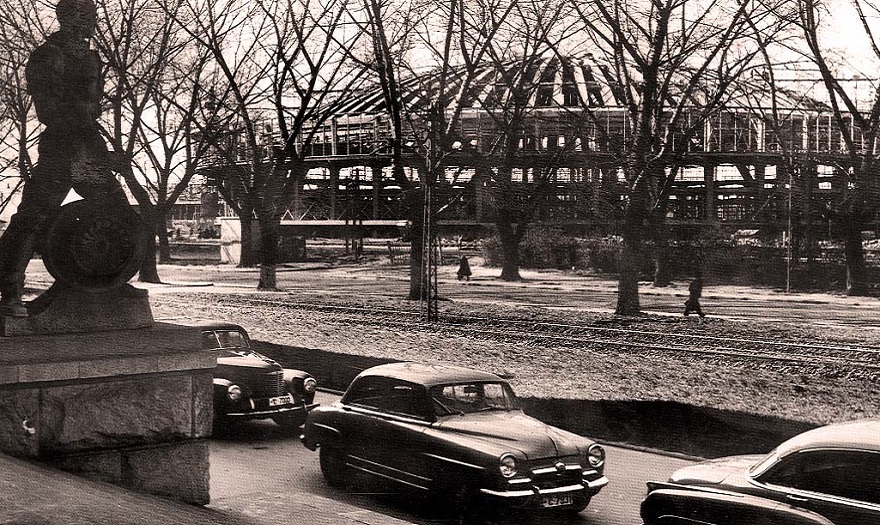IMS Institute - History
In 1929 within the Ministry of construction in the Kingdom of Yugoslavia the Institute for construction materials testing started its activities and its task was to perform control testing of construction materials which were used for buildings under the supervision of the Ministry and other regional institutions on the territory of whole Yugoslavia.
At the same time, within the Ministry of Construction there was also the Department for Bridges which had an important and advanced role in the development of construction design in the Kingdom of Yugoslavia. Bridge construction assignments often turned out to be research developmental projects which resulted in passing some modern regulations concerning reinforced concrete, in introduction of standards concerning concrete, in geomechanical researches etc. The Department has gathered a number of engineers of exceptional quality, such as:
Lancos, Tucakovic, Karpinski, Judinc, Radovanovic, Kostic, Ilic, Matic, Zezelj, Djordjevic, Sapsal, Voroncov, Eric, Popovic and others. It was a great school of excellent designers, organizers, propagandists of professional advancement and true researchers.
After the Second World War the Institute immediately continued its work within the FNRJ Ministry of Construction, performing quality control, while the Department for Bridges under the leadership of the engineer Branko Zezelj gathered excellent experts who started the reconstruction of the destroyed bridges.
In 1947 the decision establishing the Construction Institute of the FNRJ Ministry of Construction was made and the existing Department for testing materials joined it. In the beginning of 1948 the Institute was separated from the Ministry as a separate unit and Branko Zezelj was appointed as its director. The Institute started to work with a modest team, but soon the number of its assistants was increased with engineers of the first afterwar generations, such as: Dobrosav Jevtic, Branko Stojadinovic, Bosko Petrovic, Dimitrije Certic, Zivorad Certic, Ilija Stojadinovic, Predrag Zelalic and others.
In 1950 federal ministries were discontinued, and the Institute which had become renowned as a scientific research institution by then, came under supervision of the Federal Administration for the Advancement of Production.
In the beginning of 1951, the Serbian Academy of Science and Art (SANU), in the co-operation with professor doctor Mirko Ros, started realizing a new Institute for testing materials and structures, independent from the existing institutions. In the same year the engineer Branko Zezelj, the director of the Federal Institute of Construction, gives a proposal to the Minister of Construction in the People’s Republic of Serbia for forming a new Institute for testing materials SANU by the fusion of the existing institutes, laboratories and the Institute for testing materials in Belgrade. During 1951 negotiations were made which resulted in the fusion of the existing institutions: the Federal Institute of Construction with the Institute for Testing Materials, NRS Construction Institute, NRS Mechanical-Technical Institute, NRS Institute for Testing Materials, the Department ”Geobeton” of Hydroenergetic Institute, Physical-Chemical Laboratory of the Federal Planning Board and the machine workshop for making prototypes. In January 1952 a decision on constituting the Institute for Testing Materials SANU was made under the leadership of professor Mirko Ros and his deputy engineer Branko Zezelj. From January 1953 the Institute became the institution with independent financing called the Institute for Testing Materials of NR Serbia, and Branko Zezelj was appointed as its director.
During the next years the Institute continued successful development of its role as a developmental centre for many industries, including cement, wood, casting, metalworking as well as concrete prefabricates industry. The Institute is among the leading ones in the country in the construction of modern roads, development of geomechanics and funding, development of construction machines, laboratory equipment etc. One of the biggest merits of the Institute over a longer period is the development of prestressed concrete and laminated glued wood.
In its long history the Institute had a strong influence on the development of construction and together with other institutes in the country it gave an important contribution to the activities of the Yugoslav Laboratories Association. The Institute is the founder and constant pillar of the Yugoslav Association for Prestressing.
During 1965 the Science Council was formed and it consisted of all the members of the board, elected scientists and delegated members of the University. After having formed the Science Council, the Institute made a very efficient organizational form, suitable for the development of scientific research, independent from the worries of every-day management.
Recently the staff at the IMS Institute chose the quality management system based on processes management, and according to the requirements of the SRPS ISO 9001:2008 standard by which the IMS Institute was certified.
The work on innovating regulations in the field of construction and compliance with the directives of EC, and modern scientific achievements and introduction into modern construction practice has been set as the main goal in the next period.


